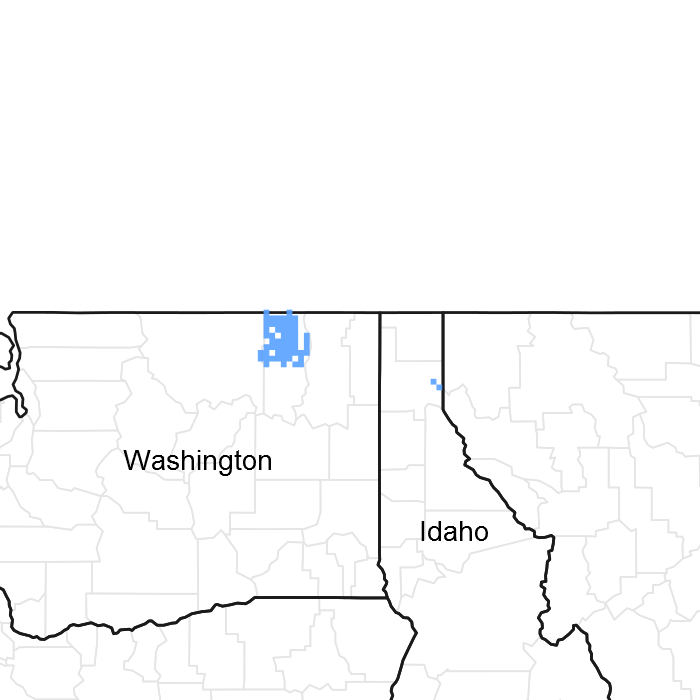
Natural Resources
Conservation Service
Ecological site F043AY512WA
Warm, Xeric, Loamy Mountainsides, ashy surface (Ponderosa Pine/Dry Grass) Pinus ponderosa / Pseudoroegneria spicata , Pinus ponderosa / Festuca idahoensis
Last updated: 3/11/2019
Accessed: 12/20/2025
General information
Provisional. A provisional ecological site description has undergone quality control and quality assurance review. It contains a working state and transition model and enough information to identify the ecological site.

Figure 1. Mapped extent
Areas shown in blue indicate the maximum mapped extent of this ecological site. Other ecological sites likely occur within the highlighted areas. It is also possible for this ecological site to occur outside of highlighted areas if detailed soil survey has not been completed or recently updated.
MLRA notes
Major Land Resource Area (MLRA): 043A–Northern Rocky Mountains
Major Land Resource Area (MLRA): 043A–Northern Rocky Mountains
Description of MLRAs can be found in: United States Department of Agriculture, Natural Resources Conservation Service. 2006. Land Resource Regions and Major Land Resource Areas of the United States, the Caribbean, and the Pacific Basin. U.S. Department of Agriculture Handbook 296.
Available electronically at: http://www.nrcs.usda.gov/wps/portal/nrcs/detail/soils/ref/?cid=nrcs142p2_053624#handbook
LRU notes
Most commonly found in LRU 43A02 (Western Selkirk Mountains).
This LRU is composed predominantly of glaciated foothills, mountain slopes and outwash terraces located in the high elevation terrain west of the Colville River and east of the Republic Graben. The LRU is in the portion of the Northern Rocky Mountains that was subjected to continental glaciation. The soils tend to be loamy andisols and inceptisols with volcanic ash surfaces. Till and outwash are the dominant parent materials though colluvium and residuum from granitic and /or metamorphic geology are also common.. Soil climate is a dominantly frigid or cryic temperature regime and xeric or udic moisture regime with average annual precipitation around 660 mm (26 inches) and an average annual air temperature around 6.2 degrees C (43 degrees F). Elevation ranges from about 645 to 1735 m (2,115 to 5,690 feet).
Also found in LRU 44A01 (Spokane-Rathdrum Outwash Plains), areas of 43A01 (Okanogan Plateau) and 43A02 (Western Selkirk Mountains).
Classification relationships
Relationship to Other Established Classifications:
United States National Vegetation Classification (2008) – A3447 Ponderosa Pine / Herbaceous Understory Central Rocky Mt. Forest & Woodland Alliance
Washington Natural Heritage Program. Ecosystems of Washington State, A Guide to Identification, Rocchio and Crawford, 2015 – Northern Rocky Mountain Ponderosa Pine Woodland and Savanna
Description of Ecoregions of the United States, USFS PN # 1391, 1995 - M332 Middle Rocky Mt. Forest-Steppe-Coniferous Forest-Alpine Meadow Province
Level III and IV Ecoregions of WA, US EPA, June 2010 - 15r Okanogan – Colville Xeric Valleys & Foothills and 15s Spokane Valley Outwash Plains
This ecological site includes the following USDA Forest Service Plant Associations: PIPO/PSSP, PIPO/FEID, and PIPO-PSME/PSSP. (Williams et. al. 1995)
Ecological site concept
This site consists of glaciated mountain slopes, and outwash terraces with the following characteristics: loamy soil materials; a water table (perched or apparent) more than 75 cm (30 in) below the soil surface during the April to October period; cumulative available water capacity to a depth of 40 inches that is > 3 inches; a surface layer with andic soil properties >7 inches thick; PIPO/FEID, PIPO/PSSP6 or PIPO-PSME/PSSP6 habitat types.
Table 1. Dominant plant species
| Tree |
(1) Pinus ponderosa |
|---|---|
| Shrub |
Not specified |
| Herbaceous |
(1) Festuca idahoensis |
Click on box and path labels to scroll to the respective text.